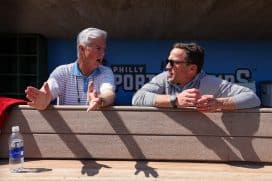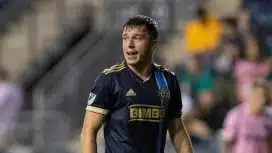Flyers
Do the Flyers Need a Full House Cleaning?
By Kevin Durso, Sports Talk Philly editor
When the puck dropped on Tuesday night’s game between the Flyers and Senators, the crowd at Wells Fargo Center was sparse. Very sparse.
Usually that amount of empty seats is reserved for games where weather comes into play. That was not the case this time. Tickets were available on secondary markets for under 10 dollars. And people weren’t interested.
The fans of this team were willing to be patient to an extent. Like Paul Holmgren and the ownership group headed by Comcast-Spectacor chairman Dave Scott, they also expected more results by now, a better product on the ice worth the time and money, but understood the process of building with prospects. The ire remained directed at a part of the organization that remained the same for Tuesday’s game and will for the next few days ahead at least.
Dave Hakstol remains the coach of this team, at least for now. That was an issue that Holmgren continued to “kick down the road.” It will be the next GM’s decision whether Hakstol stays or not.
It was ironic to listen to Holmgren talk about needing a “fresh” voice and approach to the team. Five years ago, when the Flyers fired Peter Laviolette and Hextall was the assistant GM waiting in the wings, Ed Snider adamantly insisted that the Flyers did not need a fresh perspective. Holmgren essentially ensured that the new GM would be an outside voice.
Anybody with an outside perspective would look at the product on the ice and think they had a lot of work ahead of them. Certainly, Hextall set the Flyers up well for the future with prospects and draft picks and cap space.
There wasn’t much learned in Tuesday’s press conference in regards to answers. But if you want to believe the Flyers fired the wrong guy, you would be mistaken.
The Flyers didn’t fire the wrong guy by dismissing Hextall. If Hextall wasn’t willing to budge and as “unyielding” on everything as Holmgren indicated, then he did need to go because what the team needed was change. But what the team needed to change went beyond the surface.
Hextall wasn’t going to budge in his process. If no change was coming, he was going to be the change.
Hakstol’s system, or lack thereof, is an obvious problem. When players come out completely unprepared at the start of a game or fade in the final 10 minutes, that’s as much coaching as it is playing. It’s the players job to give their best effort for 60 minutes on game night. It’s the coach’s job to have the team prepared to do that and keep order on the bench. If a team is getting "scared" and "losing confidence" — as Jake Voracek put it — because of a goal that merely cuts into a lead, you have a problem that begins on the bench and extends to the ice.
Maybe the issue on the ice, then, goes beyond Hakstol. Maybe the Flyers need to start the shed parts of the old core and start over with Hextall’s pieces — think Ivan Provorov, Travis Konecny and Nolan Patrick, even more established vets like Sean Couturier and Shayne Gostisbehere.
In addition, the Flyers could bear to clean house in other areas as well. If the team really wants a fresh perspective, keeping organizational lifers around should be frowned upon.
That starts with Holmgren, who has become more of an extension of Ed Snider as team president.
Holmgren has been with the organization in some capacity for almost every NHL season since 1976. He started as a player from 1976 to 1984. After spending parts of two seasons with Minnesota, Holmgren retired and immediately took a place behind the bench as an assistant coach under Mike Keenan. Holmgren became the first former Flyer to be named head coach in 1988. He lasted three and a half seasons before being fired.
After that, Holmgren spent the next four years out of the organization, splitting time as head coach and GM of the Hartford Whalers. When he was fired as the coach in 1995, he returned to the Flyers organization as the Director of Scouting. Starting in 1996, he was the Director of Player Personnel, a role he held for three years. In 1999, he became the team’s assistant GM, a role he held until being promoted to GM in 2006. He held the GM role until 2014, when he stepped aside for Hextall and was “promoted” to the president role.
The common thread over Holmgren’s tenure with the Flyers, which extends some 40 years now, is the Flyers championship drought. The Flyers have carried the same philosophy of knee-jerk reactions, big deals, quick changes and doing everything possible to win. That may have worked during the 90s and early 2000s. Before the lockout, there was no salary cap to tell you not to buy your way to a championship.
This is why Holmgren struggled as the GM. The team wanted to be buyers on a regular basis. Holmgren ultimately didn’t have money to spend at the end, so when big free-agent signings backfired, there was only two options — a buyout or wait it out.
Hextall’s plan ushered the Flyers into the salary cap era with the understanding that teams that were winning championships were building out their team from the ground up, not looking for the quick fix.
That was the scary part of Tuesday’s press conference. If the Flyers want to move forward by spending the cap space and trying to buy their way to a title, then they might as well have just named Holmgren GM again. The first three years of Hextall’s time as GM was spent cleaning up Holmgren’s mess — the salary cap woes and the depleted prospect pool. The last two years might have left more to be desired, but Hextall did handle the first task at hand and give the Flyers some sort of future. There’s no denying that.
If the Flyers want to get an understanding of where they are as a team with a fresh approach and perspective from an outside GM, that person may find that the problems extend far beyond the previous GM, to the coach, the players, even to the organizational lifer that holds the president’s role.
The joke often told among fans during Hextall’s time as GM was that the Flyers were a year or two away from being a year or two away from being contenders, like some never-ending cycle that replayed like Groundhog Day. In a sense, it proved to be true, at least in Dave Scott’s eyes. The Comcast CEO felt that the team should be better now and can make improvements now, not two or three years from now.
That’s all very true, this team should be farther along than they are now. But will this GM change really put them any closer to the ultimate goal? Not right away.
The Flyers will still be a year or two away because of the amount of work that needs to get done. They need more stability on the blue line. They need a goalie, one they can actually trust to get the job done and stay healthy in the time it will take for Carter Hart to be ready. They need more depth at forward, players that actually drive the play and get more production.
That was the irony of Tuesday’s game. The Flyers had taken action and made a change. Obviously, they still need to find the next GM, but it was a start to what is necessary across the organization. That still didn’t change the result or the product on the ice. Funny how that works.
By the end of the game, the fans in the stands were chanting for the coach to be the next to go, just as they were before the team ousted the GM. There was also a new one floating around social media. It was directed at Paul Holmgren.
So maybe this is the point where you forget about trying to salvage the current core, let the GM bring in his own coach and rid yourself of every internal perspective you have.
It was a question five years ago and it remains one now. The Flyers need a fresh perspective. They tried to get one from a former goalie turned GM. His patience wasn’t good enough for an impatient management group.
A look in the mirror should show that the change that was made isn’t the only one that needs to happen. Maybe someone with a fresh perspective will see that instead.












































